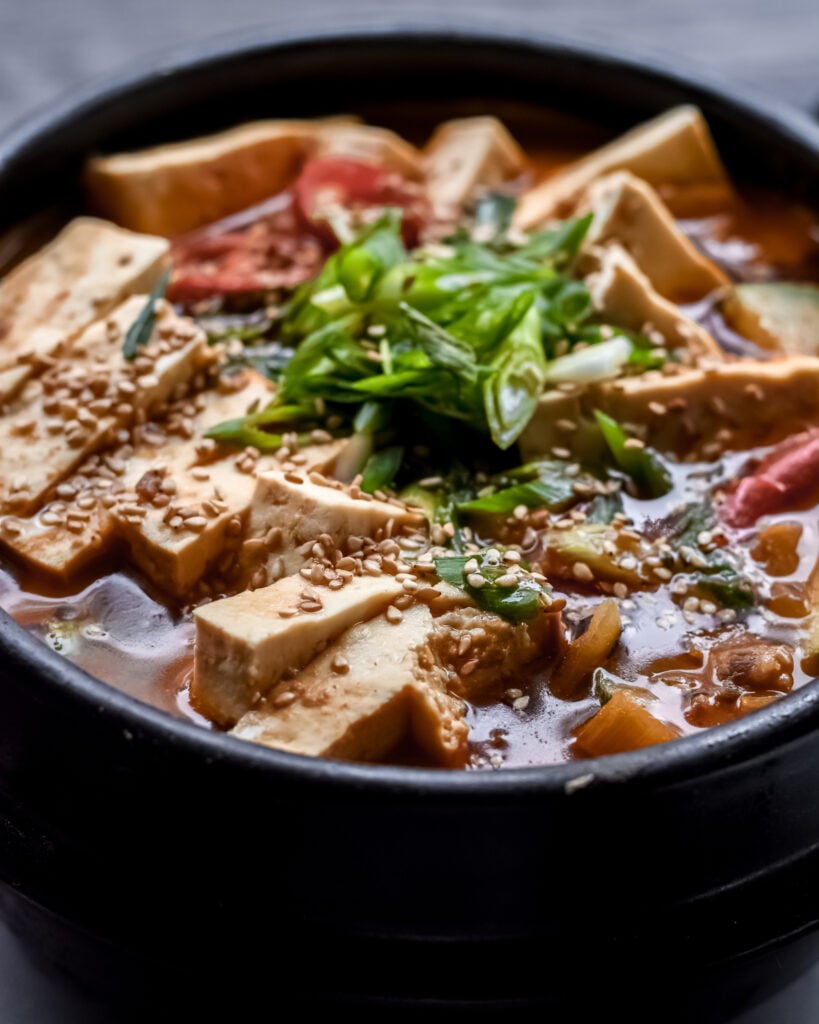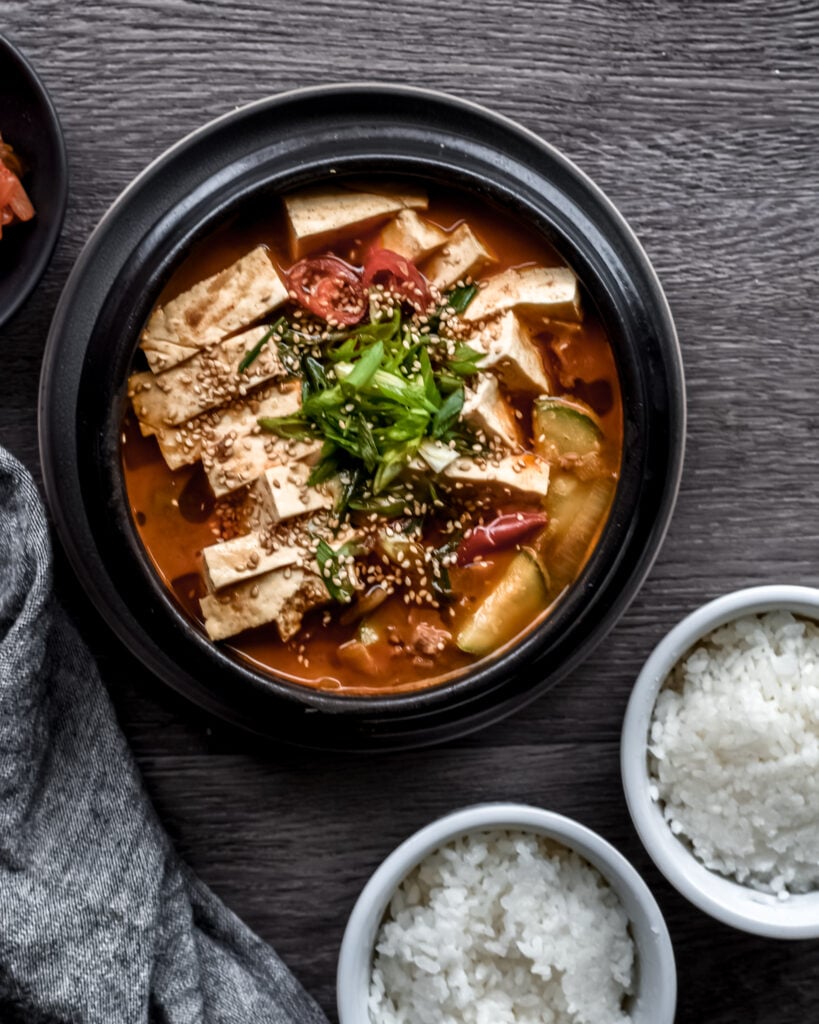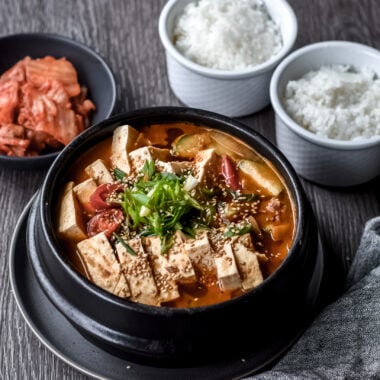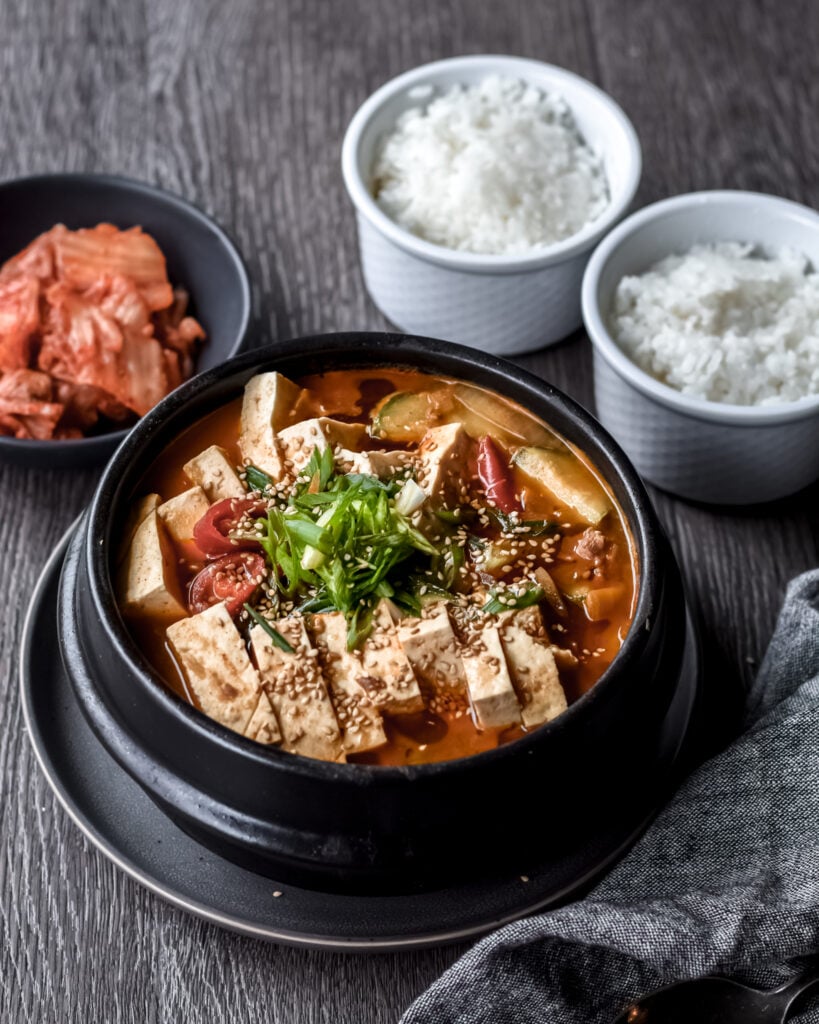Make a Korean classic: Doenjang Jjigae, also known as Soybean Paste Stew! A delicious and hearty stew flavored with savory, umami-rich soybean paste. Adding pork, vegetables, and thick tofu slices creates a 20-minute, mouthwatering, irresistible Korean soup!
What is Doenjang Jjigae?
Doenjang Jjigae is a popular Korean soup that’s often enjoyed at home. It belongs in the category of “home food” or “Jip Bap.” A delicious and savory soup that’s flavored with Doenjang or Korean fermented soybean paste.
The unique flavor of Doenjang makes this Korean soup irresistible! Not only will it thicken the broth, it will add an unforgettable flavor that’s both savory and pungent. There is no substitute!
Widely considered an everyday soup in Korean cuisine, it’s often packed with tofu, meat, and various vegetables. Feel free to change it up depending on the season, as it’s versatile and flexible. Please note my recipe is especially thick and stewy — just the way my North Korean grandma used to make it! If you prefer a thinner broth, add more water or anchovy broth.
As a bonus, it’s ridiculously simple to make at home. That’s why it’s classic Korean home cooking. Delicious AND easy — most Korean households make and eat Soybean Paste Stew several times a month.
If you’re a fan of Korean dramas, you’ll routinely see people eating this dish. That shows you the popularity of this simple but mouthwateringly delicious dish. Everyone cooks and eats it! Everyone loves it!

Ingredients:
- Doenjang. Korean fermented soybean paste. Can be found in a glass jar or plastic tub at the Korean grocery store. Salty, umami-rich, vegan, and gluten-free. Use the best you can find. At the store, there are several different types. The older and more fermented the paste, the more pungent, rich, and deep the flavor. I recommend 100-day fermented soybean paste at the Korean market for the best deep flavor.
- Water or Anchovy Stock. Anchovy stock is the basis of many Korean soups and stews. I used Anchovy tablets or Anchovy bouillon to make things easier. However, if you don’t have it — water also works just fine.
- Tofu. Medium firm to extra firm works best. If you like a softer texture, be careful as it will fall apart easily.
- Gochujang. Korean fermented chili paste. A little bit adds spice and depth of flavor.
- Onion + Garlic. The aromatics add so much flavor!
- Pork Butt/Shoulder. Good flavor and not too fatty. Pork and doenjang complement each other so well! You can also sub with pork belly, pork loin, or pork ribs. Chicken or beef are also good substitutes.
- Vegetables. Classic vegetables commonly found in Korean soybean paste stew are potato and zucchini. Potato thickens the stew. Zucchini absorbs all that thick, stewy flavor. But feel free to rummage in the fridge. Squash, pumpkin, and sweet potato thicken the stew and add a mild sweetness. Shitake, enoki, or brown mushrooms add an earthy flavor. It’s also good with leftover bits of bean sprouts and napa and/or green cabbage. You could even add kale, carrots, Asian eggplant, and Brussels sprouts, too.
- Chili Pepper. Although this Korean stew is not usually spicy, a sliced jalapeno or fresno chili adds a subtle spicy kick. For me, it’s an essential ingredient.


What is Doenjang?
Doenjang is Korean fermented soybean paste and one of the three essential “Jangs” that form the base of Korean cuisine. A fermented food item, it is deeply and intensely flavorful and salty.
Salty, savory, and full of umami depth — it’s the base of so many Korean recipes. It’s also vegan and gluten-free, making this Korean staple easy to vegetarianize or veganize.
The older the soybean paste, the darker and more pungent it will be. I prefer dark, flavorful 100 day-old Doenjang for the best taste. But if you prefer milder, regular “Mat” Doenjang works great!
Instructions:
- Cook pork and onion. In a medium saucepan, cook pork and onion until the onion is slightly wilted. (It’s ok if the pork is still pink).
- Make broth. Add water, doenjang, gochujang, garlic, and bring to a boil. Add hard vegetables (potato, squash, sweet potato), and cook until potatoes are soft, about 4-5 minutes.
- Add soft vegetables. If using softer vegetables, add them now: zucchini, cabbage, etc. Cook until soft, about 2-3 minutes.
- Add tofu and chili pepper. Drain and slice tofu. Add to the bubbling hot stew. Sprinkle the chili pepper on top. Cook until tofu is heated through.
- Adjust the seasoning. As a fermented food item, Doenjang will taste different every time. Right before serving, taste and adjust the seasoning. If it tastes flat, add a sprinkle of fish sauce. If it’s too salty, add a pinch of sugar.
- Garnish and serve! Garnish with green onion, sesame seeds, and a drizzle of sesame oil. Serve bubbling hot with rice and kimchi.
Watch how to make it:
PRO Tips:
- Find the best Doenjang you can. Homemade is best but any dark, strong-smelling kind will yield good results. I use 100-day aged paste from the Korean market.
- Add fish sauce at the end. Many Korean cooks use anchovy stock as a soup base. If you don’t have anchovy stock, substitute with a sprinkle of fish sauce at the end. Note: you probably won’t need the fish sauce if you use good doenjang.
- Serve in a Ttukbaegi (Korean clay pot). Korean earthenware clay pots are often used for various soups and stews. Although they take longer to heat, they also take longer to cool — keeping jjigae bubbling hot, even at the table. So good! I recommend a medium-sized (1000ml) Korean clay pot for my Doenjang Jjigae recipe, which serves 2.

Variations:
A classic of Korean home cooking, there are endless variations for Korean Soybean Paste Stew.
- Make it spicier. Add 1-2 Tbsp more of Gochukaru and/or Gochujang. Or add more chili peppers at the end.
- Add seasonal vegetables. Add different vegetables, depending on the time of year. I like buttercup or kabocha squash and potato in the fall and winter. For spring, bean sprouts, zucchini, and cabbage taste light and fresh.
- Change up the protein. If you don’t eat pork, swap with beef or chicken. Clams, mussels, shrimp, squid, or white fish are also good additions.
- Make it vegan. Swap the pork with shitake mushrooms for a “meaty” texture. Don’t forget to leave out fish sauce at the end to make it completely plant-based.
- Thin the broth. Add more water for a thinner broth. It won’t be so thick and chunky.

Special Equipment: Ttukbaegi or Korean clay pot
Koreans use Ttukbaegi or clay pots to cook many soups and stews. The clay pots easily transfer from stove top to tabletop. An easy, one pot meal!
Note: Clay earthenware pots take longer to heat but also take longer to cool — keeping jjigae bubbling hot, even at the table. So good!
Ttukbaegi come in different sizes. I recommend a medium-sized (1000ml) Korean clay pot for my Doenjang Jjigae recipe, which serves 2.
A medium stainless steel pot also works if you don’t own a clay pot. Cook everything as stated in the recipe. Before serving, divide between two bowls.
FAQ:
Is Doenjang the same as Miso?
They are both fermented soybean pastes. But Miso is fermented with Koji, a rice based starter — giving it a slightly sweeter, milder flavor. On the other hand, Doenjang is fermented with salt, giving it greater depth and sharpness.
I like to think of Doenjang as a souped-up miso paste. It’s more complex, deeply flavored, earthy, and pungent. It can also be quite chunky with lots of texture. Sometimes you’ll see pieces of partially crushed soybeans in the thick paste.
Do I need to use a sieve when adding it?
Doenjang can be quite chunky and textured. When added to stews and soups, distinct bits of soybeans can float on the surface. Some people prefer a less “beany” texture and use a fine mesh sieve to achieve a silkier, smoother finish.
Personally, I don’t mind the texture. But at the end of the day, it depends on what kind you use and your personal preference. Do what you like best!
If using a sieve, use a spoon to push the paste through before adding to the soup pot. A fast, easy way to remove the texture but keep the flavor.
How do I store Doenjang (Korean Soybean Paste)?
Store in the coldest part of your fridge, tightly sealed. It can dry out so make sure it’s covered well.
FYI: Doenjang is a fermented food product; it keeps aging and changing over time. The taste and color will continue to deepen. Technically, it can last several years. But over time, it will look and taste very differently!
More recipes with Doenjang:
- Ssamjang. A classic Korean BBQ condiment. Swipe onto lettuce leaves and add grilled meat of choice!
- My North Korean Grandmother’s Pork Belly. Braised deliciousness with all that homey doenjang flavor.
- Instant Pot Bossam. Another Korean classic, made easier in the Instant Pot!
More easy Korean recipes:
- Gochujang Jjigae
- Korean Steamed Eggs (Gyeran Jjim)
- Tuna Kimchi Fried Rice
- Kimchi Jjigae with Pork Belly
- Korean Street Toast

Easy Doenjang Jjigae (Korean Soybean Paste Stew)
Equipment
- 1 Medium 1000ml Claypot (Korean Ttukbaeggi) or Medium Saucepan
Ingredients
- 1/2 cup/ 8oz pork shoulder, roughly chopped
- 1 small onion, chopped
- 1 small Korean (grey) zucchini, cut into 3/4-inch chunks (about 1 cup) (can be subbed with kabocha or butternut squash
- 1 small potato, cut into 3/4-inch chunks (about 1/2 cup)
- 1 3/4 cups water or anchovy broth
- 1/4 cup Doenjang (Korean fermented soybean paste)
- 1 tsp Gochujang (Korean fermented chili paste)
- 1 garlic clove, minced
- 1 box medium or firm tofu, drained, halved and sliced
- 1 Fresno or Jalapeno pepper, sliced (optional)
- dash fish sauce (optional)
Garnish:
- 1 green onion, sliced
- drizzle sesame oil
- sprinkle sesame seeds
Instructions
- Prep pork and vegetables: Roughly chop pork shoulder. Chop the onion, potato, and zucchini. Slice chili pepper. Mince garlic.
- Cook pork and onion. In a medium clay pot (or saucepan), heat 1 Tbsp oil over medium heat. Add pork and onion, stirring occassionally. Cook until onion is mostly soft, about 2 minutes. It's ok if the pork is not completely cooked through.
- Add water + seasoning. Add water, doenjang, gochujang, and garlic. Add potato and any other hard vegetables (such as squash), if using. Bring to a boil then lower heat and simmer until potato is soft, about 5 minutes.
- Add soft vegetables. Add zucchini and other soft vegetables (cabbage, bean sprouts, etc.), if using. Cook unti soft, about 3-4 minutes.
- Add sliced tofu and chili pepper. Add tofu and chili pepper and simmer for 2-3 more minutes, until the tofu is heated through and all the flavors meld together. Spoon liquid over the tofu, if needed.
- Garnish and enjoy. Sprinkle with green onion, drizzle of sesame oil, and sesame seeds. Serve hot with rice and kimchi. Enjoy!
Video
Notes
-
- Make it spicier. Add 1-2 Tbsp more of Gochukaru and/or Gochujang. Or add more chili peppers at the end.
-
- Add seasonal vegetables. Add different vegetables, depending on the time of year. I like buttercup or kabocha squash and potato in the fall and winter. For spring, bean sprouts, zucchini, and cabbage taste light and fresh.
-
- Change up the protein. If you don’t eat pork, swap with beef or chicken. Clams, mussels, shrimp, squid, or white fish are also good additions.
-
- Make it vegan. Swap the pork with shitake mushrooms for a “meaty” texture. Don’t forget to leave out fish sauce at the end to make it completely plant-based.
-
- Thin the broth. Add more water for a thinner broth. It won’t be so thick and chunky.





Made this tonight for my family using ground pork (because that is what was available at the store) & soft tofu. It was delicious! I cut the squash & potato in advance so that the meal came together very quickly.